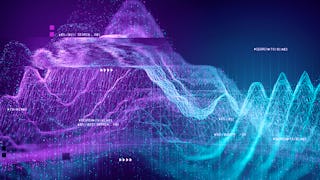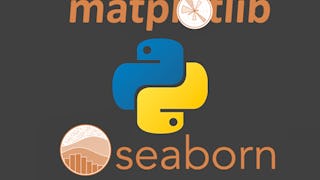This course focuses on data visualization, an essential skill for effectively communicating insights derived from data. It introduces three widely used Python packages: Matplotlib, Seaborn, and Plotly, each known for its unique capabilities in data visualization. The course covers the basics of these libraries and demonstrates how to create a variety of visualizations, from simple plots to complex interactive graphics. Through hands-on practice and case studies, students will learn how to choose the right visualization for their data, customize their plots, and create compelling visuals that convey meaningful insights. Optional case studies will allow students to deepen their understanding by applying these tools in real-world scenarios.
通过 Coursera Plus 解锁访问 10,000 多门课程。开始 7 天免费试用。


您将学到什么
Identify the strengths and differences between Matplotlib, Seaborn, and Plotly for various visualization needs.
Create a wide range of plots, including line, bar, scatter, and pie charts, using each of the three packages.
Apply data visualization techniques to real-world data, gaining deeper insights into how to use these tools for storytelling and communication.
您将获得的技能
要了解的详细信息

添加到您的领英档案
4 项作业
了解顶级公司的员工如何掌握热门技能

积累特定领域的专业知识
- 向行业专家学习新概念
- 获得对主题或工具的基础理解
- 通过实践项目培养工作相关技能
- 获得可共享的职业证书

该课程共有5个模块
This module introduces the fundamentals of the Matplotlib package, a powerful and versatile library for creating static, animated, and interactive visualizations in Python. It begins with a brief overview of Matplotlib and demonstrates how to create a simple plot. Learners will explore how to enhance visualizations by adding titles, labels, and legends, as well as how to customize the plot’s appearance with different styles, lines, and markers. Additionally, the module covers adding annotations for clarity and how to create subplots to display multiple graphs within a single figure. By the end, students will be equipped with essential plotting skills using Matplotlib.
涵盖的内容
5篇阅读材料1个作业6个非评分实验室
This module expands on the basic features of Matplotlib, guiding learners through the creation of a variety of complex plots that are essential for advanced data visualization. Starting with line, bar, and histogram plots, the module also covers scatter plots, pie charts, box plots, heatmaps, and how to manage complex subplots. These visualizations are crucial for effectively communicating patterns and insights from different types of data. By mastering these plots, students will be able to visualize complex datasets in a way that facilitates data analysis and decision-making.
涵盖的内容
1篇阅读材料1个作业8个非评分实验室
In this module, students will apply the skills learned from both the Basic and Advanced Matplotlib modules by working with the "Economy of Us" dataset. This case study challenges learners to create a variety of plots to visualize the dataset effectively. By generating multiple types of visualizations—such as line, bar, scatter, and heatmap plots—students will practice their ability to present economic data in a meaningful way. This hands-on experience reinforces key concepts and helps students solidify their understanding of Matplotlib for real-world applications.
涵盖的内容
1篇阅读材料8个非评分实验室
This module introduces Seaborn, a powerful Python visualization library built on top of Matplotlib that simplifies the creation of attractive and informative statistical graphics. Students will learn how to create various types of plots, including relational plots, distribution plots, and categorical plots, which are crucial for analyzing relationships between variables, distributions, and categories. The module also covers how to enhance visualizations by adding colors, styles, and facets for better data interpretation. Additionally, students will explore the lmplot function for fitting regression models and learn to generate multiple plots for comprehensive data analysis.
涵盖的内容
2篇阅读材料1个作业10个非评分实验室
This module introduces students to Plotly, a powerful data visualization library that enables the creation of interactive and dynamic visualizations. The module begins with an overview of what Plotly is and its advantages for data visualization. Students will learn how to create various types of plots, including scatter, line, area, bar, timeline, funnel, pie, and histogram plots. Additionally, the module will cover advanced techniques for creating 3D visualizations, such as 3D scatter plots and 3D line plots, providing learners with the skills to develop engaging and informative visual content.
涵盖的内容
2篇阅读材料1个作业12个非评分实验室
获得职业证书
将此证书添加到您的 LinkedIn 个人资料、简历或履历中。在社交媒体和绩效考核中分享。
位教师

从 Data Analysis 浏览更多内容
 状态:免费试用
状态:免费试用 状态:预览
状态:预览 状态:免费试用
状态:免费试用Duke University
人们为什么选择 Coursera 来帮助自己实现职业发展




常见问题
To access the course materials, assignments and to earn a Certificate, you will need to purchase the Certificate experience when you enroll in a course. You can try a Free Trial instead, or apply for Financial Aid. The course may offer 'Full Course, No Certificate' instead. This option lets you see all course materials, submit required assessments, and get a final grade. This also means that you will not be able to purchase a Certificate experience.
When you enroll in the course, you get access to all of the courses in the Specialization, and you earn a certificate when you complete the work. Your electronic Certificate will be added to your Accomplishments page - from there, you can print your Certificate or add it to your LinkedIn profile.
Yes. In select learning programs, you can apply for financial aid or a scholarship if you can’t afford the enrollment fee. If fin aid or scholarship is available for your learning program selection, you’ll find a link to apply on the description page.
更多问题
提供助学金,




